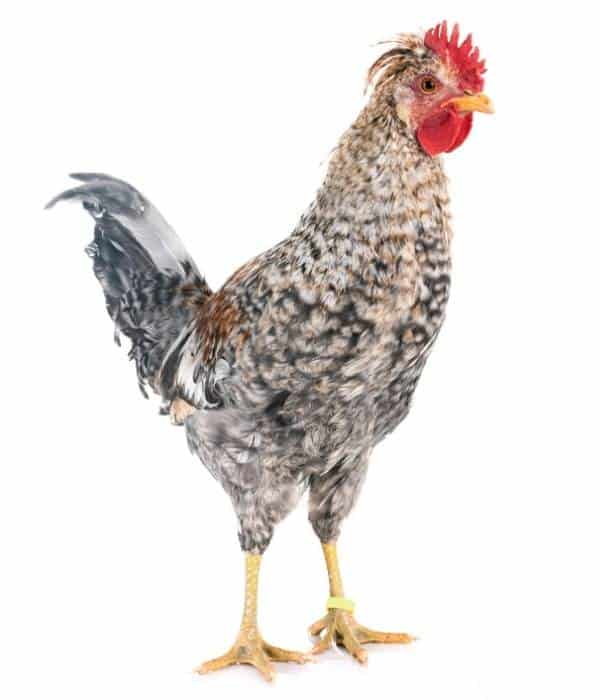The Cream Legbar chicken is a British breed over a hundred years old. It is still fairly exotic in the United States.
But now the Cream Legbar is becoming popular in the United States, and many chicken owners are trying to find out if they can benefit from this breed.
If you are also considering raising this chicken breed, you are in the right place. The complete breed guide has a lot of information on this breed, so try to read it and follow the included tips.
This guide includes history, lifespan, varieties, temperament, egg production, size, appearance, and care guide for Cream Legbars.
What is Cream Legbar Chicken?
Cream Legbar Chickens are small charming birds having big personalities, and they also have funny little quirks. These birds loved to run around the yard.
These birds are 100 years old and came from Britain. They are new to the United States. These chickens are friendly and show interest in the surroundings; watching them foraging near the coop and run area is beautiful.
This breed is the most popular autosexing chicken breed in the world. Cream Legbar are free-range birds and lay a lovely light blue or light green color egg. They are friendly chickens.
Common Names of Cream Legbar Chicken
Various names, such as Crested Cream Legbar and Opal Legbars, also known as Cream Legbar chicken.
History of Cream Legbar Chicken

This chicken breed came from Britain to the United States nearly 100 years ago. This breed was a mix of Plymouth Rocks and Brown Leghorn, Golden Campine genetics.
It inherits suitable traits from these birds and makes beautiful and colorful eggs. Read the list of chickens that lay colored eggs.
The Legbar breed was developed by Reginald Punnett and Michael Pease at Cambridge University in the early 1900s. Reginald Punnett also created Punnett Square.
These scientists wanted to create good egg-laying breeds.
Scientists crossed the Gold Legbar with White Leghorn and Cream Araucana. These Araucanas were rumpless, not the tufted American type. After breeding, the Plymouth Rock heritage contributed.
The Leghorn heritage contributed to excellent egg-laying ability. Araucana heritage contributes blue and green eggshells and an adorable crest.
In 1930, a prominent horticulturist named Clarence Elliott offered Punnett South American Araucana chickens during the trip, and these chickens laid blue eggs.
Professor Punnett started crossing these birds with a gold-penned Hamburg. Countless crossings created Cream-colored birds. The evolution of chicken came across in recessive genetics. Professor never saw this type of color in chickens.
Professor Pease, working in shuffling cream coloring, males crossed their birds, and Cream Legbar was born in 1970. Cream Legbar nearly faded. All of a sudden, now chicken lovers have started to prefer Cream Legbar Chicken once again.
Lifespan of Cream Legbar Chicken
Cream Legbar Chicken has an average lifespan of about 5-9 years. Their life expectancy varies due to their living conditions, feed, and nutrition.
Egg Production
Cream Legbar Chickens are better known for their beautiful blue eggs, and it has three colored varieties; gold, silver, and cream.
These chickens have strong Leghorn chicken genes and are proficient egg producers. It starts laying around the age of 5-6 months and lays around 180-200 eggs per year.
Legbars are famed for their egg color. Some Cream Legbar Chicken has a crown and lays blue turquoise eggs. It is considered a rare poultry breed by the Fowl Club of Great Britain and falls under their Rare Poultry Culture category.
These are sex-linked birds; you can see the difference between males and females by looking at the back. Female birds have a visible dark chipmunk stripe, whereas male birds have a distinctive stripe.
Temperament of Cream Legbar Chicken

These Cream Legbar chickens are not particularly friendly and are very cautious about anything harmful.
They are alert and active foragers, so they are known for free-ranging. Because of the Leghorn lineage, these birds are unlikely to go broody.
Here is our definitive guide on Chicken brooding guide.
Cream Legbars are loud and difficult to control. Some birds are temperamentally easy to handle, even when faced with conflicting personalities.
The Cream Legbar is a unique chicken that is careful and smart about predators. Roosters can be opposite peculiarly in crossbreeding and also in reproducing season.
Here are few best chicken wire and hardware cloth for making predator-safe fencing.
The Cream Legbar chicken is good for eco-friendly egg production but not a great winter month layer.
Roosters are easy to tame and prefer to be free-range. They also dislike being placed under arrest. They may be aggressive during the mating season.
Color, Size, Appearance, Characteristics of Cream Legbar Chicken
Color and Appearance
The Cream Legbar has a triangular designed body with a long, level back. The eyes of this alight fowl are red bay in color; earlobes are cream color, sometimes white as well, whereas the beak is yellow to horn tinted.
The chicken has a wide shoulder that leads into a slightly sloped back. The Cream Legbars wings were close to its body.
The Cream Legbar chicks are available in shades of red and brown and have chipmunk striping coming down from their backs.
Size
Cream Legbars are small birds, with roosters weighing around 6-7.5 lbs and hens weighing 4.5-6 lbs.
These breeds have close-fitting feathers, which appear to be very small. This bird seems small at first glance because these birds have tight and close-fitting feathers.
Characteristics of Cream Legbar Chicken
Legbars are a peaceful breed that will get along with other standard-size chickens. They will do well in a mixed-breed flock.
These are autosexing breeds, so males and females look different during hatching. Hatcheries often use a vent sexing technique that is only 90 percent accurate, so it’s possible you could end up with roosters when you ordered female chicks.
Cream Legbars are very tough and hardy birds that can survive most climatic changes. Combs of Cream Legbars are prone to frostbite, just like other breeds. They also have medium to large-size single combs.
These Cream Legbars are excellent free-range birds and are wary of predators. They love to explore and forage.
Benefits of Raising Cream Legbar Chicken

Here are some significant benefits of raising Cream Legbar Chicken in the backyard-
- These are very low-maintenance birds when it comes to feeding. They are free-range birds and love to be in their coop. They have access to plenty of grasses to find bugs. Here is the mega list of chicken treats.
- These birds do not need ample space for the coop; they are not significant. A bird requires a minimum of 2-3 feet of space in a pen. The Cream Legbars are very active and love to forage.
- They do not have specific health issues; we must check the feathers on their crest because external parasites inhabit them.
- Breeding and selling eggs can be profitable. These are very rare breeds that have excellent egg production quality.
- Cream Legbar Chickens are tough and hardy birds that survive most climatic changes.
- These birds are peaceful in a mixed-breed flock. They go well with other chicken breeds in the flock, as they are autosexing. You can differentiate between female and male during hatching itself.
Problems in Raising Cream Legbar Chicken
Below are some common problems which you may see during raising Cream Legbar Chickens-
- Every so often, these breeds will give eggs with a white shell, which is caused by recessive traits appearing in the hens. Some Legbars stop laying eggs in winter because some strains don’t lay well in winter.
- Legbar hens sometimes become broody; some strains may be less broody than others.
- They will destroy the land for over-forage; they will dig and scratch everything inside the coop or the yard.
- Cream Legbar Chicken doesn’t lay eggs in winters or they lay very few eggs. Read how to keep chickens warm in winter?
Care Guide for Cream Legbar Chicken
As we know, cream legbars are a great forager, so we need to consider the patrol location for them.
- Feeding– These birds are quite low maintenance birds when it comes to feeding them. They are great foragers, so try to keep them in a place where they can get access to lots of grass and places where they can find bugs. For optimal feather growth, be sure to provide a good amount of protein during the molt.
- Housing- Because they are small birds, they can live in a small area in the coop and run. Chicken proprietors suggest a minimum of 2 square feet per bird in the run and a minimum of 3 square feet in the coop. You can check out our guide on some portable chicken coop designs.
- Health issues and care– These birds are not prone to any diseases and health issues. It’s a good idea to check their crest feathers from time to time to make sure that external parasites like lice or mites aren’t living there. To prevent your chicken from this parasite, use various products for the prevention and treatment of lice. You can also read our guide on chicken dewormers.
Conclusion
The Cream Legbar chicken is now firmly preferred over other breeds in the United States and its homeland. Their light blue and light green eggs are absolutely stunning.
Also, Cream Legbar chickens look cute with little feathers crests that grow behind their combs.
Cream Legbar chickens have some unique features that many chicken keepers like to add to their flocks.


